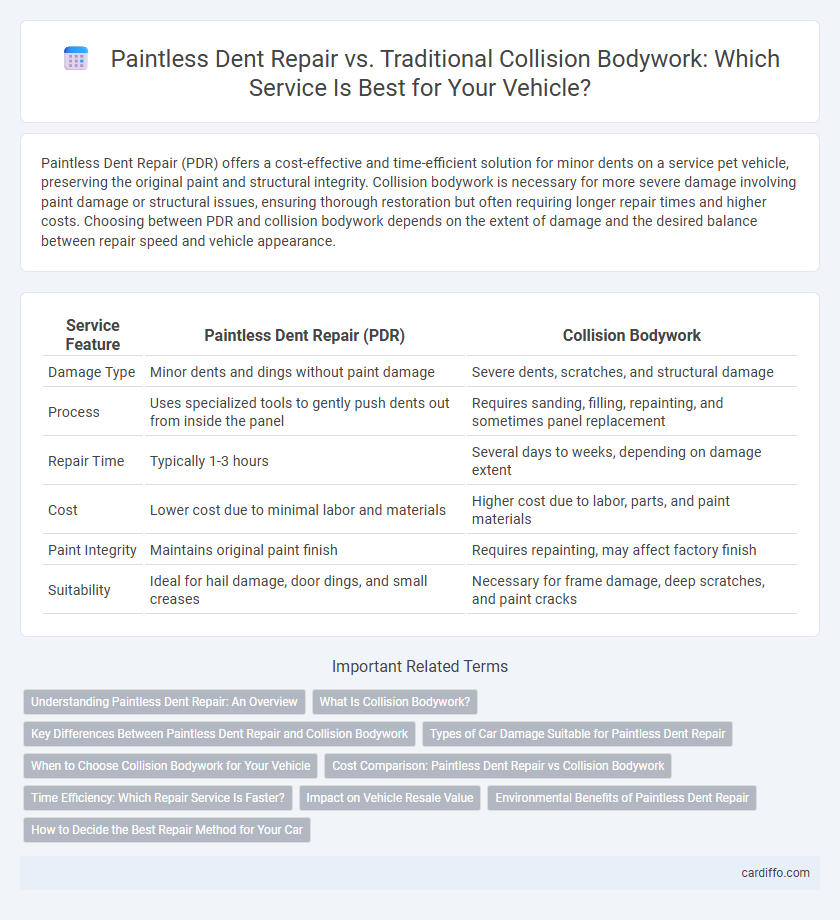Paintless Dent Repair (PDR) offers a cost-effective and time-efficient solution for minor dents on a service pet vehicle, preserving the original paint and structural integrity. Collision bodywork is necessary for more severe damage involving paint damage or structural issues, ensuring thorough restoration but often requiring longer repair times and higher costs. Choosing between PDR and collision bodywork depends on the extent of damage and the desired balance between repair speed and vehicle appearance.
Table of Comparison
| Service Feature | Paintless Dent Repair (PDR) | Collision Bodywork |
|---|---|---|
| Damage Type | Minor dents and dings without paint damage | Severe dents, scratches, and structural damage |
| Process | Uses specialized tools to gently push dents out from inside the panel | Requires sanding, filling, repainting, and sometimes panel replacement |
| Repair Time | Typically 1-3 hours | Several days to weeks, depending on damage extent |
| Cost | Lower cost due to minimal labor and materials | Higher cost due to labor, parts, and paint materials |
| Paint Integrity | Maintains original paint finish | Requires repainting, may affect factory finish |
| Suitability | Ideal for hail damage, door dings, and small creases | Necessary for frame damage, deep scratches, and paint cracks |
Understanding Paintless Dent Repair: An Overview
Paintless Dent Repair (PDR) involves carefully massaging dents from a vehicle's exterior without affecting the original paint, preserving its value and finish quality. This technique is ideal for minor damages such as hail dents or door dings, offering cost-effective and faster restoration compared to traditional collision bodywork. Unlike collision repairs that require repainting and panel replacement, PDR maintains the factory finish while minimizing labor and material expenses.
What Is Collision Bodywork?
Collision bodywork involves repairing vehicle damage caused by accidents using techniques such as panel replacement, frame straightening, and repainting to restore the car's original structural integrity and appearance. This process addresses both cosmetic and functional aspects of the vehicle, often requiring specialized tools and professional expertise to ensure safety compliance and durability. Unlike paintless dent repair, collision bodywork handles more extensive damage, including broken parts and compromised panels.
Key Differences Between Paintless Dent Repair and Collision Bodywork
Paintless Dent Repair (PDR) maintains the original factory paint, effectively removing minor dents without sanding or repainting, which preserves the vehicle's value and reduces repair time. Collision Bodywork involves extensive repairs including panel replacement, sanding, filler application, and repainting, suitable for severe damage, structural issues, or when paint is cracked or chipped. PDR is cost-effective and eco-friendly, while collision bodywork requires more resources, skilled labor, and longer turnaround times.
Types of Car Damage Suitable for Paintless Dent Repair
Paintless Dent Repair (PDR) is highly effective for repairing minor dents, such as hail damage, small door dings, and parking lot dents that do not involve paint damage or metal deformation. Unlike traditional collision bodywork, which requires sanding, filling, and repainting, PDR preserves the original factory finish by manipulating the metal back to its original shape. This technique is best suited for shallow dents where the paint remains intact, making it a cost-effective and faster alternative for certain types of car damage.
When to Choose Collision Bodywork for Your Vehicle
Collision bodywork is necessary when your vehicle has extensive damage involving structural components, frame alignment issues, or compromised safety features that paintless dent repair cannot address. It is the preferred choice for severe dents, major scratches, or damage affecting the vehicle's mechanical parts and paint integrity. Opting for collision bodywork ensures comprehensive restoration, maintaining both the appearance and safety of your vehicle.
Cost Comparison: Paintless Dent Repair vs Collision Bodywork
Paintless Dent Repair (PDR) typically costs between $75 and $150 per dent, making it a cost-effective solution for minor dings and hail damage. Collision bodywork expenses vary widely but often range from $500 to $2,500 depending on the severity of the damage and parts replacement needs. Choosing PDR over traditional collision repairs can save up to 70% in costs while preserving the original paint finish.
Time Efficiency: Which Repair Service Is Faster?
Paintless Dent Repair (PDR) offers significantly faster turnaround times compared to traditional collision bodywork, often completing repairs within a few hours to a day. This method avoids extensive disassembly, painting, and curing processes, which can extend collision bodywork repairs to several days or even weeks. Choosing PDR enhances time efficiency by restoring vehicle panels quickly without compromising quality.
Impact on Vehicle Resale Value
Paintless Dent Repair (PDR) preserves the original factory paint and structure, significantly maintaining the vehicle's resale value by avoiding costly body replacements or repainting. In contrast, traditional collision bodywork often involves repainting and panel replacements, which can reduce resale value due to potential mismatched paint and structural alterations. Vehicle buyers prioritize original paint condition and structural integrity, making PDR a preferred option for maximizing resale returns.
Environmental Benefits of Paintless Dent Repair
Paintless Dent Repair (PDR) significantly reduces environmental impact by eliminating the need for harmful chemicals and paints commonly used in traditional collision bodywork. This repair method conserves raw materials and minimizes waste, as it preserves the original vehicle panels instead of replacing them. PDR's eco-friendly approach not only supports sustainability but also decreases energy consumption throughout the repair process.
How to Decide the Best Repair Method for Your Car
Choosing between Paintless Dent Repair (PDR) and collision bodywork depends on the severity and type of damage; PDR is ideal for minor dents and dings without paint damage, preserving the original finish and costing less. Collision bodywork becomes necessary when there are large dents, deep scratches, or structural damage requiring repainting and panel replacement. Consulting a certified auto repair professional ensures the best method for restoring your vehicle's safety, appearance, and value.
Paintless Dent Repair vs Collision Bodywork Infographic

 cardiffo.com
cardiffo.com